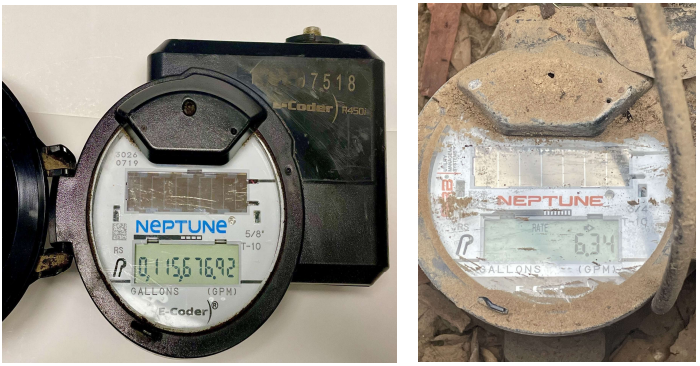UNDERSTANDING YOUR WATER METER
CHWW meters are digital. To read your water meter, open the round top cover of the meter. You may notice when your first open the lid that nothing is displayed. This is because light needs to activate the display function. Sunlight may wake up the display or you may shine a light (LED if possible) toward the top row of squares and the display should appear. Digital displays will show two readings: The overall meter read and then blink over to the flow rate. The flow rate will tell you gallons per minute currently being used.
LEAK DETECTION TEST
STEP 1 Locate your meter box, generally found towards the front of a property, near the street in the utility easement. The box is typically in a direct line with the main outside faucet. It is housed in a concrete, or black meter box and may be marked with the service address. Remove the lid by using a tool such as a large screwdriver. Insert the tool into one of the holes and pry the lid off.
STEP 2 Once you open the meter box lid, lift the protective cap on the meter. Wake up the display with light if needed. Read the number display from left to right, do not include numbers after the decimal point. This is your meter reading. Ensure all faucets and spigots that use water are off. Observe the flow rate for several flashes (approx 10). If you your number is higher than 0 on any flashes, you may have a leak. For slow leaks it is suggested to read the meter, then wait 20 minutes and read the meter again. Subtract the first read from the second, and if greater than zero, something is running or you have a leak.
STEP 3 Radio scanned reads are done by CHWW on the first of every month, so you are likely checking your meter on a date different from the one used for billing. Since we only charge water after it is used, the current bill will be for a previous month. This could result in a difference in the amount you find, compared with the amount on which your bill is based. However, if your reading is considerably higher than what is on your bill, check for a leak or try to determine the source of large water use. If there is no obvious visible leak, keep in mind that it may be underground. It is also helpful to check for dropping faucets, running toilets and sprinkler systems that only leak when running. Be sure to check out our FAQs regarding how sprinkler system schedules affect your bill.


 Read & Flow Rate
Read & Flow Rate